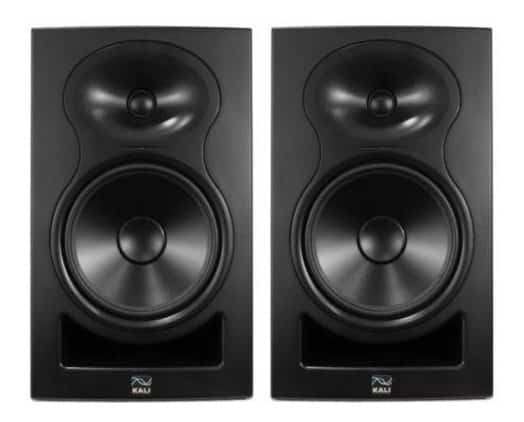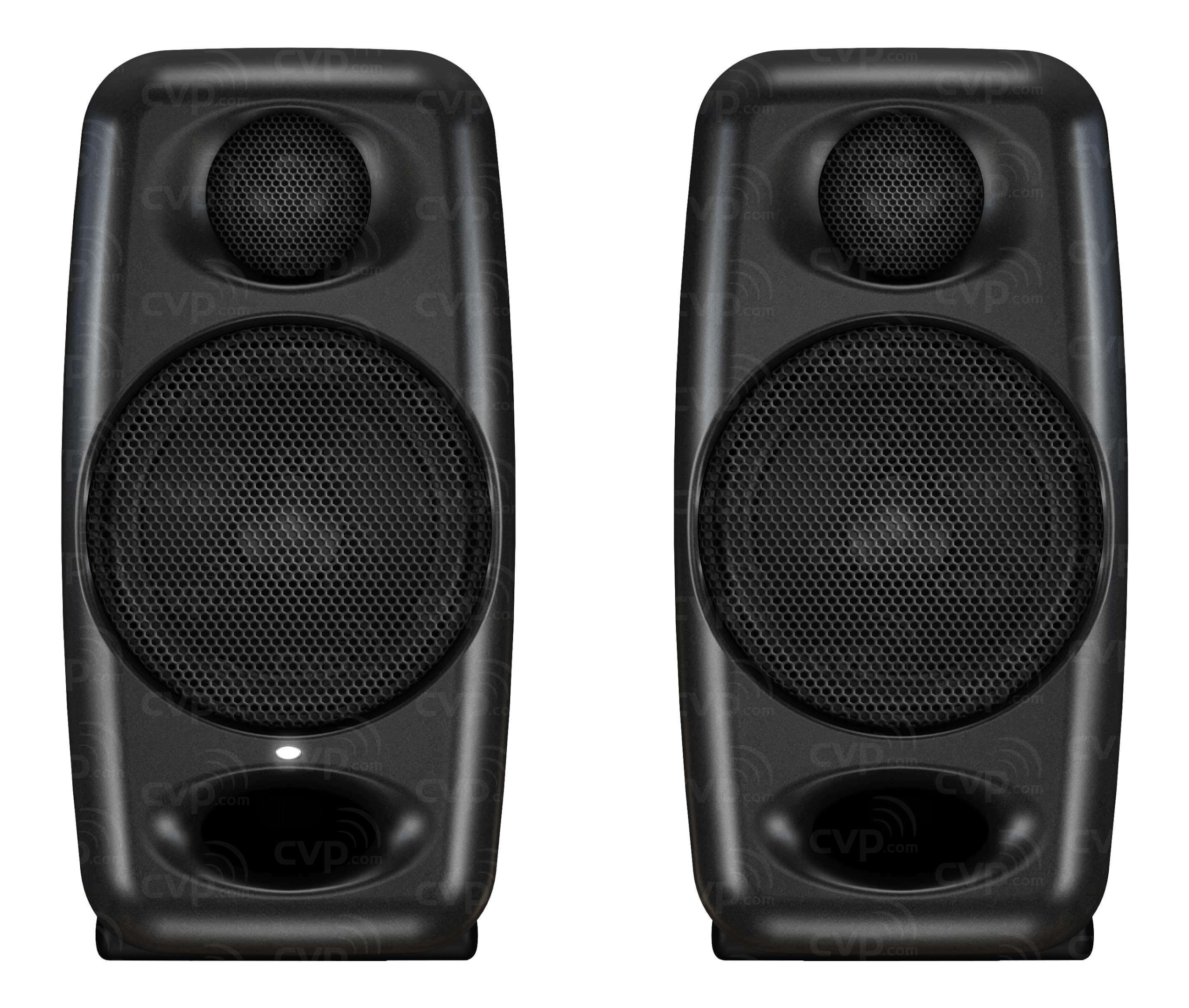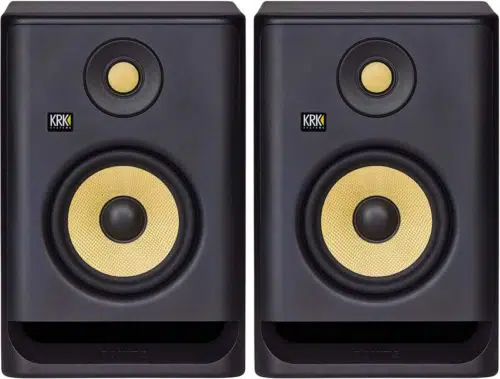Last updated on December 29th, 2023 at 09:50 pm
Studio monitors are probably the single most important piece of equipment in your studio since they are, essentially, your “ears”, letting you hear what is going on in the mix and allowing you to make changes as needed.
However, high-quality studio monitors are generally really expensive, especially the high-end ones. But the truth is that you can get your hands on a pair of $300 studio monitors and these are already good enough for producing music that sounds professional.
In this article, I will be listing the best studio monitors in the $300 price range, as well as tell you what pair I consider to be the best.
So, without any further ado, let’s get started!

Kali LP-6
Great-sounding studio monitors with a flat frequency response. Best overall under $300.

iLoud Micro
Extremely high-quality small-format studio monitors with a flat frequency response.

Adam T5V
Features a ribbon tweeter capable of reproducing the high-frequency content in great detail.
What makes a Good Studio Monitor?
A good studio monitor should provide minimal distortion, exceptional stereo imaging, a wide frequency response, neutral sound coloration (sound flat), and a high volume level even with a small cabinet.
Studio monitors vary a lot and depending on your needs, the kind of music you’re producing, etc., you might find one more appealing than the other, but there are some general factors you should always consider before buying.
Flat Sound
Monitors are generally designed to sound flat, which simply means that whatever audio source the computer is sending to the monitors, the monitor speakers will reproduce accurately without adding any sort of coloration, or EQ.
This makes it easier for you to really gauge what is going on in the mix and to reach for the right plugins to make corrections faster. It’s worth noting, however, that some studio monitors are designed to do the complete opposite, and by that, I mean that they purposely emphasize problematic areas in the mix to help you correct them faster (this is extremely common in the Yamaha HS lineup).
Sound Distortion
Studio monitors should never distort the sound, even if they are pushed to their limits. This is because they are designed to help producers accurately and objectively listen to the mix, and distortion will, well, “distort” the information that they are getting.
Stereo Imaging
Being able to properly place a sound source in the stereo field is hugely important when producing music since it’s one of the factors that make music interesting, and having monitors that accurately place those sources in the stereo field is really important.
There are some other quality-of-life features that may be beneficial for you, such as built-in EQ to make the monitors sound better in your room, but the three I just listed are by far the most important.
What is the Best Studio Monitor under $300?
Despite there being a lot of different studio monitors available in the $300 price range, there’s one pair that stands out: The Kali LP-6.
The Kali LP-6 are newly released monitors that are specifically designed for music production and mixing and that punch way above their weight, and they are definitely the ones I would recommend for any home studio, and even for professional studios as secondary monitors.
They have a flat frequency response and the best sound quality, which allows for all the different frequencies to be heard with great accuracy, which means that you will be able to hear to everything that is going on in the mix allowing you to make better decisions at the time of reaching for different plugins.
List of the Best Studio Monitors under $300
Here I will be listing the studio monitors under $300 that I consider to be the best, with the first three on the list being my top choices and in that order.
So, let’s get into the list.
Kali LP-6
Best Studio Monitors under $300, period.

The Kali LP-6 are, in my opinion, the absolute best studio monitors you can get for $300 since they do everything that a studio monitor is supposed to do extremely well. In fact, they sound better than a lot of the more expensive monitors out there.
The Kali LP-6 have a surprisingly flat sound signature which is crucial when producing music since you don’t want your speakers over-emphasizing a specific frequency range while masking another (this is very common with more affordable studio monitors since they overly boost the low- and high end while still sounding unintelligible).
On the back, they come with a couple of EQ switches that allow you to adjust their sound signature to better sit in the room you have them set up in, making it a lot easier to get them sounding right.
When working with the Kali LP-6 you can listen and mix for long periods of time at reference volume, and momentary peaks such as bass drops or explosion effects will come through clearly and with minimal distortion thanks to their 20dB headroom (again, at reference volume).
If you only have a $300 budget and are looking for a great pair of studio monitors to produce music, mix, and even master your own songs, then I would recommend the Kali LP-6 since they are an all-around excellent product: The 6.5” woofer reproduces the low end extremely well and lets you hear to what is going on in the mix with great detail, where the 1” dome tweeter is capable of reproducing the high end with great fidelity and without over-hyping it.
They are also really good speakers in general that can be used for gaming, watching movies, and regular music listening.
- What makes the Kali LP-6 a good choice: They have a flat sound signature and reproduce all of the audio content very precisely, which gives them the most accurate sound reproduction of all the monitors on this list.
Get the Kali LP-6 here: Amazon, Sweetwater.
IK Multimedia iLoud Micro
Best small form factor Studio Monitors!

These small form factor powered studio monitors may not seem like professional speakers but believe me, they are. They only feature a small 3” woofer and a ¾” silk dome tweeter, but they definitely don’t sound small, in fact, many pro studios use them on a daily basis for mixing, or as secondary monitors to check the mix because of how good they sound.
They are designed to sit on your desk facing slightly upwards and they feature adjustable isolation bases that decouple them from the desk, so you don’t even need to use monitor stands or foam pads to keep them from spreading sound vibrations.
The iLoud Micro speakers feature Bluetooth connectivity as well as some simple EQ options to make them sound good in your room.
Just like the Kali-LP6, the iLoud Micro monitors have an extremely flat frequency response, making them ideal for anything music production related, and despite their woofer’s small size, they reproduce the low end (45Hz and on) really well without sounding muddy at all.
Essentially, if you need studio monitors that really reproduce sound accurately to allow you to make the proper decisions when mixing, you can’t go wrong with these.
- What makes the IK Multimedia iLoud Micro a good choice: Super small studio monitors that fit on any desk, they have a superb sound quality and also sound extremely flat making them ideal for any home recording enthusiast.
Note: These are generally selling for $340 or so, but you can get the Demo version for much less if it’s available.
Get the iLoud Micro Monitors here: Amazon, Sweetwater.
Adam T5V
Studio Monitors with the best High End!

The Adam Audio T5V have always been considered as some of the best budget studio monitors mainly because of their ribbon-style tweeter that reproduces the high-end frequency content up to 25kHz a lot more accurately than any of the other speakers in this price range.
The 5” woofer is quite good at delivering a high-quality and good sounding low end, up to 45Hz, although it’s worth mentioning that the bigger the driver, the better it is at reproducing low-end frequencies, generally speaking.
They are small and light speakers with a very respectable build quality, and on the back, they have a gain control, as well as two 3-way switches labeled “LF” and “HF” that boost or cut the monitor’s respective high- and low-frequency responses by 2 dB, which lets you adjust their sound a bit depending on your room’s acoustics.
The Adam T5V definitely excel in accurately reproducing the high-frequency content and it’s also why I put them on this list since this is generally where a lot of issues present themselves in the mixing phase, and being able to properly listen to the mix lets you make better decisions, resulting in an overall more polished product.
- What makes the Adam T5V a good choice: They have the best high frequency sound thanks to the ribbon tweeter.
Get the Adam T5V here: Amazon, Sweetwater.
Yamaha HS5
They accentuate problematic areas in the Mix!

The Yamaha HS5 are near-field powered studio monitors with a 5” woofer and a 1” tweeter. Their bigger brother, the HS8’s, have been an industry standard for years now, but not because of how great or flat they sound, but because they accentuate problematic areas in the mix (mids and upper mids), which allows you to have a more critical listen of those frequencies to be able to fix them.
Essentially, if a mix sounds great on the Yamaha HS5’s, 7’s or 8’s, it sounds great anywhere!
Similar to the Adam T5V, the Yamaha HS5s are small and light speakers with a very respectable build quality, and on the back, they have a gain control, as well as two 3-way switches labeled “High-Trim” and “Room Control” that boost or cut the monitor’s respective high- and low-frequency responses by 2 dB at 2kHz and 500Hz respectively, which lets you adjust their sound a bit depending on your room’s acoustics.
The Yamaha HS5 studio monitors are not designed to sound pleasing but rather to accentuate all of the problems in the mid frequencies of your mix, helping you identify those problems and fix them, which is why I would highly recommend them for music production, but not so much for listening to music, gaming, watching movies, etc.
Note: These are generally a bit more expensive than $300 for a pair, but I’ve seen them on sale for about $280, so make sure to keep an eye out.
- What makes the Yamaha HS5 a good choice: They overly emphasize the most problematic area in a mix, the mid and high-mid section, letting you detect and deal with those issues faster.
Get the Yamaha HS5 here: Amazon, Sweetwater.
JBL 305P MkII 5
Great Sound at low volume to check the balance of the mix.

The JBL’s 305P MkII active studio monitors are a nearfield monitor solution for any audio engineer or home music producer that needs affordable monitors at a relatively low price.
The JBL 305P MkII are designed to be able to reproduce audio accurately even at extremely low levels, which is generally used to tell if your mix is properly balanced or not, and many cheaper studio monitors aren’t capable of reproducing all of the frequencies properly once they are taken below a certain volume threshold, and the JBLs can do this without any issues.
They feature two built-in EQ switches called “Boundary EQ” and “HF Trim” that let you adjust the frequency response slightly to make them sit better in your room.
These are pretty balanced-sounding studio monitors, making them ideal for music production and mixing since they won’t overly emphasize any part of the mix.
- What makes the JBL 305P MkII 5 a good choice: They have a fairly flat sound signature and reproduce all of the audio content very precisely.
Get the JBL 305P MKII 5 here: Amazon, Sweetwater.
PreSonus Eris E5 XT
Better sonic sweet spot than most Studio Monitors!

The PreSonus Eris E5 XT are studio monitors that feature a 5” woven composite woofer and a silk dome 1” tweeter designed mainly for music production.
They offer some acoustic tuning via the mid and high-frequency knobs that allow you to cut or boost 6dB, as well as a low cut at 80Hz or 100Hz up to -4dB which helps you to get them sounding right in your current space, although they don’t offer as much control over as the Kali LP-6 or the KRK Rokit 5 G4.
As far as the frequency response goes, they do have a slightly uneven frequency response since the extremes (highs and lows) are way more boosted than the mid section (smiley face EQ), which means that they arent really “flat-sounding” monitors.
Having said that, they do sound great, especially when compared to the rest of the Eris lineup.
What really makes the Eris 5 XT stand out is the wide sonic sweet spot that they have, which is thanks to PreSonus’s EBM waveguide which narrows the vertical dispersion of the sound and decreases reflections from your desk, supplying you with a clean sound that allows you to not have to be seated precisely in the sweet spot to get an accurate representation of how the audio actually sounds.
- What makes the PreSonus Eris E5 XT a good choice: They have a wider sonic sweet spot than most other Studio Monitors.
Get the PreSonus Eris E5 XT here: Amazon, Sweetwater.
Mackie CR5-X
Affordable yet great-sounding alternative!

The Mackie CR5-X are active monitors that offer a great value for money since they are very affordable (about $200 for the pair) and they can work quite well for producing and mixing music. However, they are mainly designed with the intention of being used as general multimedia speakers and don’t offer the flattest frequency response out there, in fact, they have a fairly boosted low and high end with a dip in the mids.
This means that they won’t sound as flat as something like the Kali LP-6, but they are still an extremely good alternative considering the low price.
Contrary to most speakers on this list, the Mackie CR5-X don’t come with any EQ control over the audio itself to help you adjust them to your room and you will need to rely on software to do this.
If you’re looking for a set of studio monitors around the $200 mark, then the Mackie CR5-X might be a good choice.
- What makes the Mackie CR5-X a good choice: Great in terms of cost-efficiency.
Get the Mackie CR5-X here: Amazon, Sweetwater.
Avantone Pro MixCubes
Reproduces the sound of bass-challenged audio systems!

Avantone’s MixCubes mini reference monitors give you the ability to hear what your mixes will sound like on bass-challenged real-world systems such as computers, televisions, car stereos, and iPod docking stations.
What this means is that they will actually help you mix in such a way that your music will have an easier time translating into the real world, which clearly is one of the main issues producers struggle with.
Now, just as a side note, you can’t only rely on these speakers when mixing but rather use them for referencing and to check the mix in a multitude of ways, since otherwise you won’t be able to properly process the low end because these speakers don’t reproduce it.
If you already have a pair of high-quality speakers, such as the Kali-LP6 or the iLoud Micro Monitors, then these Avantone Pro MixCubes might come in handy to help you produce better end-results.
- What makes the Avantone Pro MixCubes a good choice: They will help your mixes translate better into the real world because they sound like bass-challenged systems (not enough low end), which is quite common for car stereos, the systems used in bards and restaurants, computers, etc.
Get the Avantone Pro MixCubes here: Amazon, Sweetwater.
KRK Rokit 5 G4
Best built-in EQ that can be controlled via an App!

The KRK Rokit 5 Studio monitors are extremely popular, especially in the DJ and EDM circles, and you may have probably seen loads of home studios that have these.
They feature a 5” woofer and a 1” tweeter made out of Kevlar which ensures that the sound is evenly distributed off the cone, which is one of the reasons they are so popular.
The KRK Rokit 5 feature an LED screen and a whole lot of EQ options that you can use to adjust the sound so that they sit well in your room, plus you can download the App to get real-time access to spectral analysis, and it can also help you with monitor placement, subwoofer level adjustment, and more.
The KRK Rokit 5 G4 may have a bit of a boomier sound when compared to something like the Kali LP-6 or the Adam T5V, which is why they are so popular with DJs, but they do sound more balanced than most other studio monitors in this price range, and having the highly versatile EQ options directly built-in means that you can really get in and tailor the sound until it fits your needs.
- What makes the KRK Rockit 5 G4 a good choice: They have a fairly flat frequency response and they offer the best in-depth built-in EQ out of all the monitors on this list, plus an app that can do spectral analysis, and more.
Note: The Rokit 5 G4 are generally selling for about $350 for the pair, but I’ve seen them on sale for roughly $300.
Get the KRK Rokit 5 G4 here: Amazon, Sweetwater.
Pioneer DJ DM-50D
Designed specifically for DJs!

Since the Pioneer DJ DM-50D are made specifically with DJs in mind, it’s safe to assume that they put a huge emphasis on the bass of the speakers since DJs are always looking for that pumping bass to keep the crowd interested and, of course, you also need an audio system in your studio that is capable of reproducing that kind of low end.
In addition to the bass being a bit exaggerated, the mid section is also slightly boosted and then it starts tapering off from there, making these monitors not the most flat-sounding ones out there, but again, they are mostly aimed at DJs who are looking for a tight bass response!
If you’re a DJ who needs an affordable pair of speakers, then definitely check these out!
- What makes the Pioneer DJ DM-50D a good choice: Excellent for DJs since they have a great low frequency sound and because they make those low frequencies stand out more.
Get the Pioneer DJ DM-50D here: Amazon, Sweetwater.
Honorable Mentions
The monitors I’ll include in this section didn’t make the list because they are much more affordable and definitely not as good, since you can get a pair for as low as $100, but they are excellent starting-off points for anyone who is on a budget or who is just getting started with music production.
If you’re looking for cheap studio monitors way under $300, then these might fit the bill!
PreSonus Eris E4.5 and E3.5
The PreSonus Eris E4.5 and E3.5 are consistently being marketed as high-quality and affordable studio monitors and, while they may be good starting options, they definitely are not the type of studio monitor I would recommend to anyone who is at least somewhat serious about making music since they don’t sound flat, they mask a lot of the frequency content making it hard to really hear to the mix in detail, etc.
That being said, they are extremely cost-efficient and you probably won’t be able to get any other kind of affordable studio monitor for the price that these sell at since the pair of Eris E3.5 sell for about $100 and the Eris E4.5 for roughly $170.
If you don’t know whether or not producing music is for you, then the PreSonus Eris E3.5 and Eris E4.5 are a great starting point.
Get the PreSonus Monitors Here:
- PreSonus Eris E3.5: Amazon, Sweetwater.
- PreSonus Eris E4.5: Amazon, Sweetwater.
Mackie CR4-X
These are similar to the PreSonus Eris E4.5 monitors and feature a 4” woofer and a 0,75” tweeter.
They are speakers mainly designed for multimedia reproduction and not so much for music production, which means that they don’t have the flattest frequency response out there, but they can still work as a good starting off point for anyone who is on a tight budget.
Get the Mackie CR4-X here: Amazon, Sweetwater.
What to Expect from $300 studio monitors?
Luckily, most studio monitors in the $300 range are actually pretty darn good and can be used for producing professional-sounding music without any problems. Sure, you might get better results with a pair that costs $5000 but it will definitely depend more on your actual skills as a producer than on the monitors themselves.
If you get the monitors that I recommend the most, which are the Kali LP-6 and the IK Multimedia iLoud Micro monitors, then you can expect to have a really nice and flat-sounding pair of monitors that should last you forever.
Even if you decide to upgrade at some point, these monitors can definitely still be used as a second pair.
Conclusion
The Kali LP-6 and the IK Multimedia iLoud Micro Monitors are by far the best ones on this entire list since they sound extremely flat and reproduce audio with fantastic quality.
If none of the monitors on this list tickle your fancy, then always take into account the considerations I listed in the beginning that you should have when purchasing a pair.
